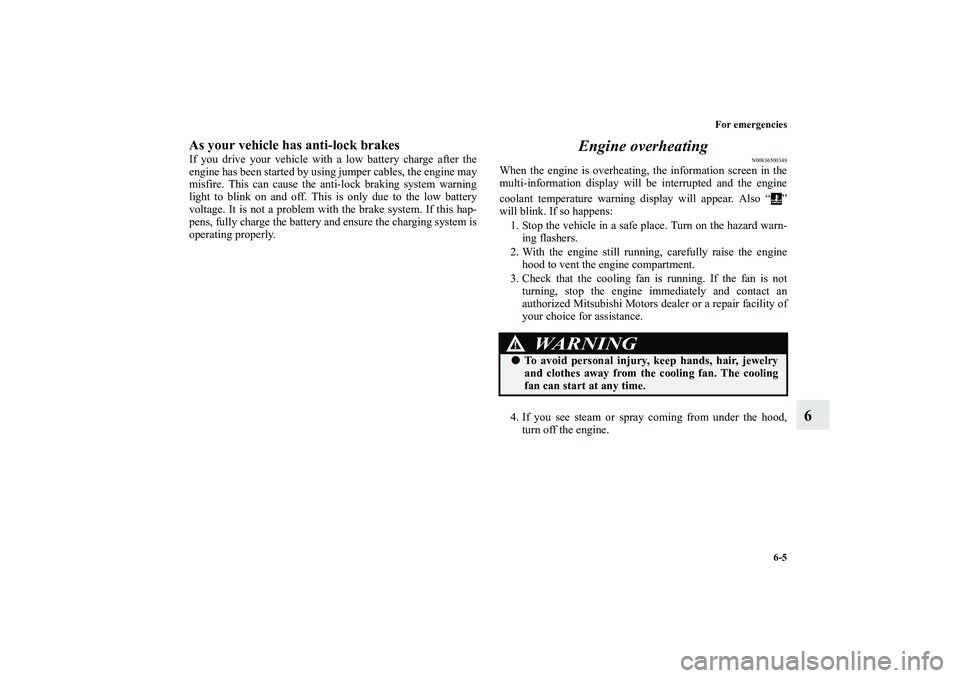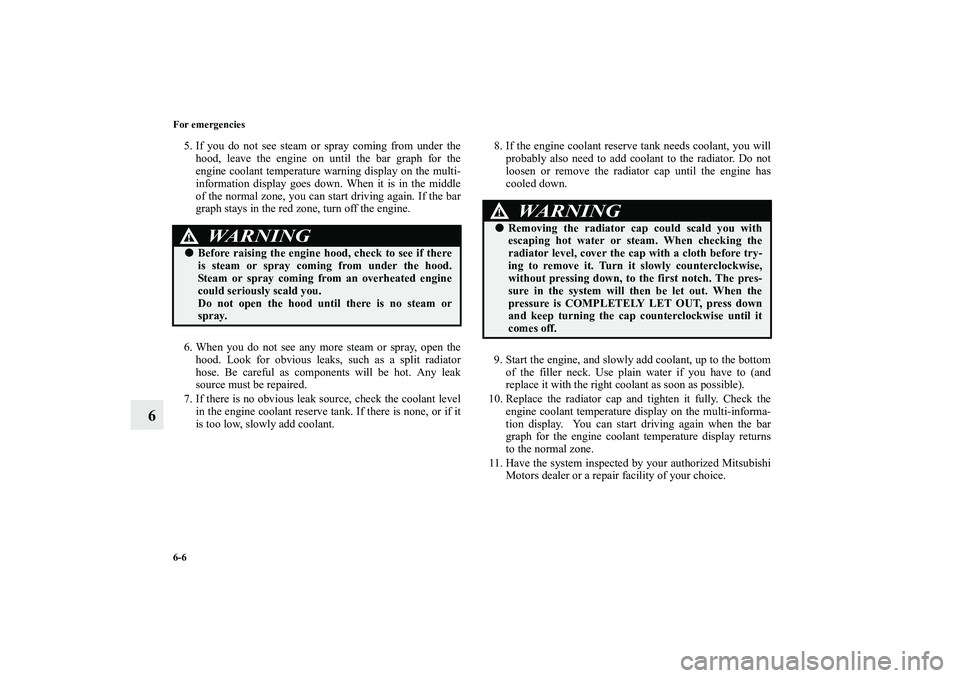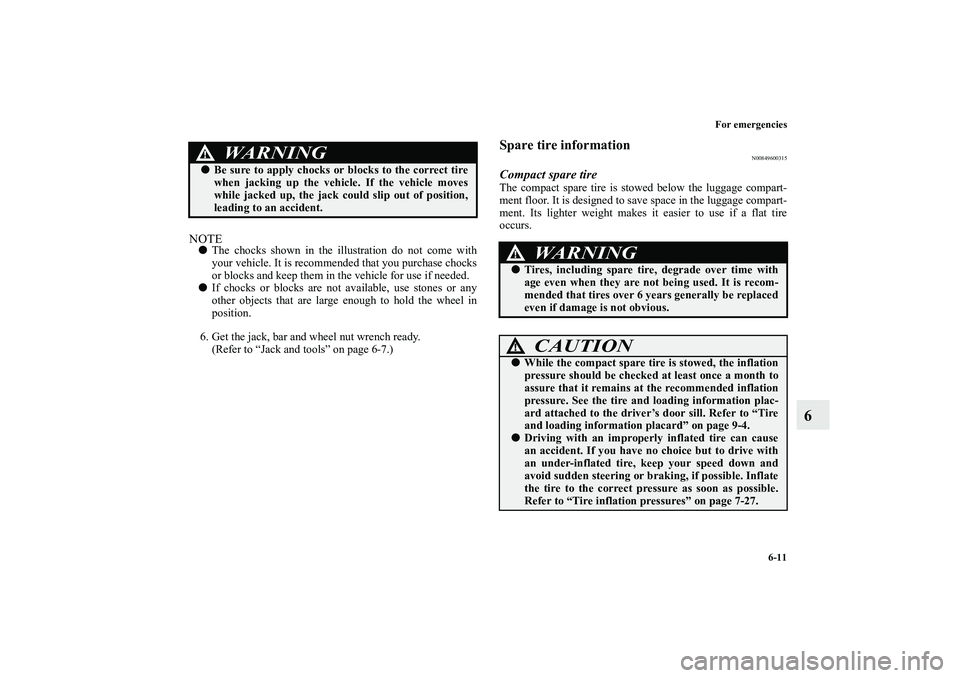Page 578 of 714

For emergencies
6-5
6
As your vehicle has anti-lock brakesIf you drive your vehicle with a low battery charge after the
engine has been started by using jumper cables, the engine may
misfire. This can cause the anti-lock braking system warning
light to blink on and off. This is only due to the low battery
voltage. It is not a problem with the brake system. If this hap-
pens, fully charge the battery and ensure the charging system is
operating properly.
Engine overheating
N00836500349
When the engine is overheating, the information screen in the
multi-information display will be interrupted and the engine
coolant temperature warning display will appear. Also “ ”
will blink. If so happens:
1. Stop the vehicle in a safe place. Turn on the hazard warn-
ing flashers.
2. With the engine still running, carefully raise the engine
hood to vent the engine compartment.
3. Check that the cooling fan is running. If the fan is not
turning, stop the engine immediately and contact an
authorized Mitsubishi Motors dealer or a repair facility of
your choice for assistance.
4. If you see steam or spray coming from under the hood,
turn off the engine.
WA R N I N G
!�To avoid personal injury, keep hands, hair, jewelry
and clothes away from the cooling fan. The cooling
fan can start at any time.
BK0138000US.book 5 ページ 2011年4月13日 水曜日 午前11時17分
Page 579 of 714

6-6 For emergencies
6
5. If you do not see steam or spray coming from under the
hood, leave the engine on until the bar graph for the
engine coolant temperature warning display on the multi-
information display goes down. When it is in the middle
of the normal zone, you can start driving again. If the bar
graph stays in the red zone, turn off the engine.
6. When you do not see any more steam or spray, open the
hood. Look for obvious leaks, such as a split radiator
hose. Be careful as components will be hot. Any leak
source must be repaired.
7. If there is no obvious leak source, check the coolant level
in the engine coolant reserve tank. If there is none, or if it
is too low, slowly add coolant.8. If the engine coolant reserve tank needs coolant, you will
probably also need to add coolant to the radiator. Do not
loosen or remove the radiator cap until the engine has
cooled down.
9. Start the engine, and slowly add coolant, up to the bottom
of the filler neck. Use plain water if you have to (and
replace it with the right coolant as soon as possible).
10. Replace the radiator cap and tighten it fully. Check the
engine coolant temperature display on the multi-informa-
tion display. You can start driving again when the bar
graph for the engine coolant temperature display returns
to the normal zone.
11. Have the system inspected by your authorized Mitsubishi
Motors dealer or a repair facility of your choice.
WA R N I N G
!�Before raising the engine hood, check to see if there
is steam or spray coming from under the hood.
Steam or spray coming from an overheated engine
could seriously scald you.
Do not open the hood until there is no steam or
spray.
WA R N I N G
!�Removing the radiator cap could scald you with
escaping hot water or steam. When checking the
radiator level, cover the cap with a cloth before try-
ing to remove it. Turn it slowly counterclockwise,
without pressing down, to the first notch. The pres-
sure in the system will then be let out. When the
pressure is COMPLETELY LET OUT, press down
and keep turning the cap counterclockwise until it
comes off.
BK0138000US.book 6 ページ 2011年4月13日 水曜日 午前11時17分
Page 581 of 714
6-8 For emergencies
6
Removing and storing the jack and toolsTo r e m o v e1. Turn the knob (A) counterclockwise and remove the lid
(B).2. Undo the securing band (C) around the tools and remove
the tools.
BK0138000US.book 8 ページ 2011年4月13日 水曜日 午前11時17分
Page 582 of 714
For emergencies
6-9
6
3. Retract the jack to remove it from the attaching hardware
(D).
To s t o r e1. Retract the jack, then return it to its original position.
2. Extend the jack and firmly set it in its storage area.
3. Place the tools back in the tool case, return the case to its
original position and firmly fix it in place with the secur-
ing band.
4. Attach the lid and tighten the knob by turning it clock-
wise.
To retract
To retract
To e x t e n d
BK0138000US.book 9 ページ 2011年4月13日 水曜日 午前11時17分
Page 583 of 714
6-10 For emergencies
6How to change a tire
N00836900747
Before changing a tire, first stop your vehicle in a safe, flat
location.
1. Park the vehicle on level and stable ground.
2. Be sure that the parking brake is firmly set and that the
selector lever is in the “P” (PARK) position.
3. Turn on the hazard flashers and turn the ignition switch to
the “LOCK” position.
4. Set up a warning triangle, flashing signal light, etc., at an
adequate distance from the vehicle, and have all your pas-
sengers leave the vehicle.5. To prevent the vehicle from rolling when it is raised on the
jack, place chocks or blocks (A) in front of and behind the
tire that is diagonally opposite from the tire (B) you are
changing.BK0138000US.book 10 ページ 2011年4月13日 水曜日 午前11時17分
Page 584 of 714

For emergencies
6-11
6
NOTE�The chocks shown in the illustration do not come with
your vehicle. It is recommended that you purchase chocks
or blocks and keep them in the vehicle for use if needed.
�If chocks or blocks are not available, use stones or any
other objects that are large enough to hold the wheel in
position.
6. Get the jack, bar and wheel nut wrench ready.
(Refer to “Jack and tools” on page 6-7.)
Spare tire information
N00849600315
Compact spare tireThe compact spare tire is stowed below the luggage compart-
ment floor. It is designed to save space in the luggage compart-
ment. Its lighter weight makes it easier to use if a flat tire
occurs.
WA R N I N G
!�Be sure to apply chocks or blocks to the correct tire
when jacking up the vehicle. If the vehicle moves
while jacked up, the jack could slip out of position,
leading to an accident.
WA R N I N G
!�Tires, including spare tire, degrade over time with
age even when they are not being used. It is recom-
mended that tires over 6 years generally be replaced
even if damage is not obvious.
CAUTION
!�While the compact spare tire is stowed, the inflation
pressure should be checked at least once a month to
assure that it remains at the recommended inflation
pressure. See the tire and loading information plac-
ard attached to the driver’s door sill. Refer to “Tire
and loading information placard” on page 9-4.�Driving with an improperly inflated tire can cause
an accident. If you have no choice but to drive with
an under-inflated tire, keep your speed down and
avoid sudden steering or braking, if possible. Inflate
the tire to the correct pressure as soon as possible.
Refer to “Tire inflation pressures” on page 7-27.
BK0138000US.book 11 ページ 2011年4月13日 水曜日 午前11時17分
Page 586 of 714
For emergencies
6-13
6
2. With the wheel nut wrench, loosen the tire hanger mount-
ing bolt by turning it counterclockwise.
3. Raise the lower gate until it clicks and locks.
Refer to “Flap-fold tailgate: To close” on page 3-60.4. Lift up the section of the tire hanger (B) that is marked
with the arrow in the illustration and remove it from the
hook (C). Then lower it and remove the tire.
CAUTION
!�While checking the tire hanger, carefully loosen the
tire hanger mounting bolt. Loosening it too much
could pull out the hook and cause the compact spare
tire to drop.
CAUTION
!�When hooking or unhooking the tire hanger, be sure
to hold the tire hanger firmly to prevent it from
dropping on your foot.
BK0138000US.book 13 ページ 2011年4月13日 水曜日 午前11時17分
Page 588 of 714
For emergencies
6-15
6
3. Open the lower gate.
Refer to “Flap-fold tailgate: To open” on page 3-60.
4. With the wheel nut wrench, firmly tighten the tire hanger
mounting bolt by turning it clockwise.
5. Install the cover over the tire hanger mounting bolt.
To change a tire
N00849800418
1. On vehicles with wheel covers, first remove the covers
(refer to “Wheel covers” on page 6-23). Then, loosen the
wheel nuts with the wheel nut wrench. Do not remove the
wheel nuts yet.
CAUTION
!�Confirm that the tire hanger is firmly secured after
storing the spare tire. If the tire hanger is not
secured, it could drop out while driving, causing an
accident.�When hooking or unhooking the tire hanger, be sure
to hold the tire hanger firmly to prevent it from
dropping on your foot.
BK0138000US.book 15 ページ 2011年4月13日 水曜日 午前11時17分